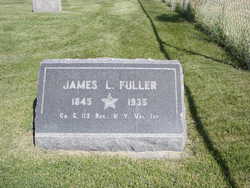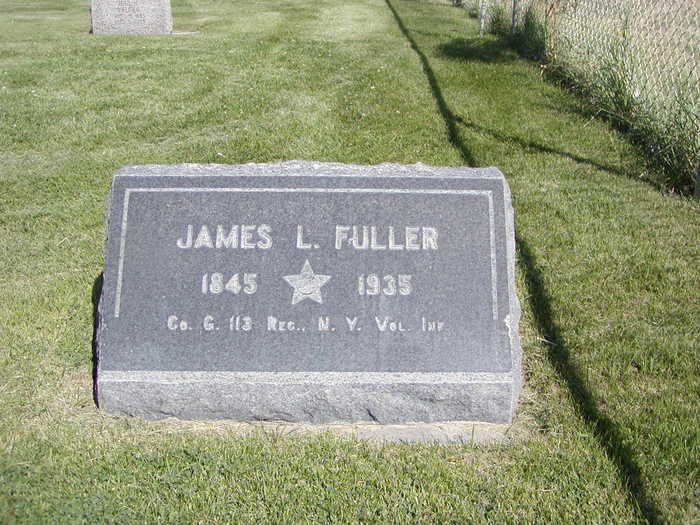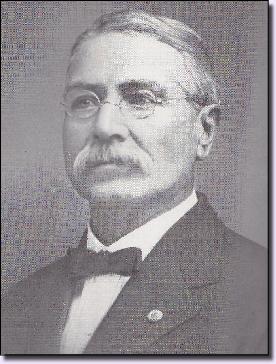He received his early education in the public schools of Allegany County, after which he began taking academic courses. However, after two years of higher education, James left school and enlisted in the U.S. Army on July 25, 1862. It is probable that he lied about his age in order to enlist since the official records list James as being eighteen years old, when in actuality he was only seventeen.
Pvt. Fuller was assigned to Company G, of the 130th New York Infantry, and with it was dispatched to Suffolk, Virginia and the Peninsula, where it served in Gen. Erasmus D. Keyes' Corps.
On January 30, 1863, the regiment was assigned to a special expedition under Brig. Gen. Michael Corcoran, in pursuit of a Confederate force under Brig. Gen. Roger A. Pryor. The expedition set out from Suffolk about 1a.m., and the two bodies met two hours later at Deserted House, Virginia. They immediately began an artillery duel, which lasted until 5:30 a.m. At that point, Corcoran ordered his forces to advance, and after several hours they were able to force Pryor's army to evacuate their position and retreat. For its part in the engagement, the 130th New York Infantry lost seven killed and eight wounded.
There is often some confusion when attempting to accurately identify this regiment. This is largely due to the fact that it had several official names during the war. On July 28, 1863, the 130th New York Infantry was transferred into the mounted service, and on August 11th it was re-designated the 19th New York Cavalry . However, its designation was again changed on September 10th, when it was renamed the 1st New York Dragoons. During its entire mounted service, the regiment was assigned to the 1st Cavalry Division, Army of the Potomac, and served exclusively in Virginia.
Its first fight as a cavalry unit was near Manassas Junction on October 17, 1863, where the regiment sustained a loss of 10 killed, wounded and missing.
They were with Grant on his campaign of 1864. At the Battle of the Wilderness on May 7-8, the unit was dismounted and fought desperately at Todd's Tavern, where they sustained a loss of 20 killed, 36 wounded, and 35 missing. This was the heaviest loss of any cavalry regiment in any one action during the war.
Later that month the regiment participated in Maj. Gen. Phil Sheridan's raid to the James River, and on May 11, 1864 it took part in the Battle of Yellow Tavern, in which Confederate General J. E. B. Stuart was killed.
At Cold Harbor near the end of May, the tired troopers were aroused from their sleep on the ground and ordered into the breastworks, which they gallantly defended throughout the night, inspired by the music of their band. Their losses at Cold Harbor amounted to 35 killed, wounded and missing.
Although reduced in numbers, the regiment then moved with Gen. Sheridan on the raid to Trevilian Station in June, where they were warmly engaged, losing 16 killed, 61 wounded, and 8 missing. This was the largest all-cavalry battle of the Civil War, involving nearly 16,000 troopers.
The regiment continued with Gen. Sheridan in his Shenandoah Valley campaign of 1864, including the battles of Opequan (September 19), Port Republic (September 26), and Cedar Creek (October 19). It was during the latter engagement that Gen. Sheridan made his famous ride from the town of Winchester, some twenty miles away. During the fray, Confederate Gen. Jubal Early had quickly gained the upper hand and was on his way to winning a decisive victory when Sheridan arrived on the field and rallied his troops for an assault, which led to victory. The outcome of the battle helped insure Abraham Lincoln's reelection the following month.
During the Appomattox Campaign of 1865, the regiment was engaged at Five Forks (April 1), Petersburg (April 2), Sailor's Creek (April 6), and finally at Appomattox Court House (April 9), where the unit was present during the negotiation and surrender of Robert E. Lee's Army of Northern Virginia.
While serving his country, James L. Fuller advanced through the ranks from Private, to Corporal, to Sergeant, finally achieving the responsible rank of Quartermaster Sergeant. He was subsequently mustered out on June 30, 1865 at Cloud's Mills, Virginia, after having taken part in forty-four engagements.
After leaving the army, James returned home to New York, where he engaged in farming for two years. At the age of twenty-two, he decided to come west and accordingly made his way to Iowa. There he spent one year in railroading, but about 1870 he again moved west, settling in Nevada. For a number of years he was engaged in teaming and freighting from the town of Elko, in Elko County, to Pioche, in Lincoln County. He hauled the machinery into the latter town for the first smelter that was established there.
In November 1874 he moved to Idaho, locating first at Marsh Lake, where he took up a government homestead and remained for five years. He then traded his land and moved to a ranch on Dry Creek, where he stayed for about two years.
James' next venture was in mining on the Snake River, near the town of Bliss. While living here, he met Alice Amanda Decker. She was the daughter of Aaron Decker and Lydia Miner, and was born October 10, 1862 in Cleveland Township, LeSeuer County, Minnesota. Her father, Aaron Decker, had served in the 1st Minnesota Heavy Artillery during the Civil War and died just ten days after being discharged. Her mother, Lydia, subsequently moved to Idaho where she married David B. Bliss.
Alice A. Decker and James L. Fuller were married on August 3, 1879. The union produced eleven children, as follows: Mildred Idella, James Elmer, Truman Craig, Bertha Josephine, Margaret Eliza, Russell David, Aaron Decker, Amos Gilbert, John Luman, Alice Sheridan, and Theodore.
While living in the Bliss area, James established a mercantile business, which he conducted until 1902, and for many years was also postmaster there. He served as County Commissioner of Lincoln County, Idaho, being first appointed to that position by Governor McConnell when Lincoln County was first established, and later being elected to the office. In 1905, he began his service as a member of the Shoshone School Board, having come to that city in 1902 and established himself in the hotel business, continuing to conduct a popular hostelry for three years. At the end of that period, James was appointed Probate Judge of Lincoln County to fill a vacancy, and was subsequently elected to the office four times. He was a staunch Republican and a popular comrade of the Grand Army of the Republic, probably belonging to the U.S. Grant Post #8 in Shoshone. In 1896 James Fuller was elected Commander of the Department of Idaho, G.A.R.
He took great pleasure in hunting and fishing, was very fond of reading, and was the owner of a fine private library. James Luman Fuller died on June 2, 1935, at the ripe old age of 90, having survived his wife by just over one year. Both were laid to rest in the cemetery at Shoshone, Idaho.
He received his early education in the public schools of Allegany County, after which he began taking academic courses. However, after two years of higher education, James left school and enlisted in the U.S. Army on July 25, 1862. It is probable that he lied about his age in order to enlist since the official records list James as being eighteen years old, when in actuality he was only seventeen.
Pvt. Fuller was assigned to Company G, of the 130th New York Infantry, and with it was dispatched to Suffolk, Virginia and the Peninsula, where it served in Gen. Erasmus D. Keyes' Corps.
On January 30, 1863, the regiment was assigned to a special expedition under Brig. Gen. Michael Corcoran, in pursuit of a Confederate force under Brig. Gen. Roger A. Pryor. The expedition set out from Suffolk about 1a.m., and the two bodies met two hours later at Deserted House, Virginia. They immediately began an artillery duel, which lasted until 5:30 a.m. At that point, Corcoran ordered his forces to advance, and after several hours they were able to force Pryor's army to evacuate their position and retreat. For its part in the engagement, the 130th New York Infantry lost seven killed and eight wounded.
There is often some confusion when attempting to accurately identify this regiment. This is largely due to the fact that it had several official names during the war. On July 28, 1863, the 130th New York Infantry was transferred into the mounted service, and on August 11th it was re-designated the 19th New York Cavalry . However, its designation was again changed on September 10th, when it was renamed the 1st New York Dragoons. During its entire mounted service, the regiment was assigned to the 1st Cavalry Division, Army of the Potomac, and served exclusively in Virginia.
Its first fight as a cavalry unit was near Manassas Junction on October 17, 1863, where the regiment sustained a loss of 10 killed, wounded and missing.
They were with Grant on his campaign of 1864. At the Battle of the Wilderness on May 7-8, the unit was dismounted and fought desperately at Todd's Tavern, where they sustained a loss of 20 killed, 36 wounded, and 35 missing. This was the heaviest loss of any cavalry regiment in any one action during the war.
Later that month the regiment participated in Maj. Gen. Phil Sheridan's raid to the James River, and on May 11, 1864 it took part in the Battle of Yellow Tavern, in which Confederate General J. E. B. Stuart was killed.
At Cold Harbor near the end of May, the tired troopers were aroused from their sleep on the ground and ordered into the breastworks, which they gallantly defended throughout the night, inspired by the music of their band. Their losses at Cold Harbor amounted to 35 killed, wounded and missing.
Although reduced in numbers, the regiment then moved with Gen. Sheridan on the raid to Trevilian Station in June, where they were warmly engaged, losing 16 killed, 61 wounded, and 8 missing. This was the largest all-cavalry battle of the Civil War, involving nearly 16,000 troopers.
The regiment continued with Gen. Sheridan in his Shenandoah Valley campaign of 1864, including the battles of Opequan (September 19), Port Republic (September 26), and Cedar Creek (October 19). It was during the latter engagement that Gen. Sheridan made his famous ride from the town of Winchester, some twenty miles away. During the fray, Confederate Gen. Jubal Early had quickly gained the upper hand and was on his way to winning a decisive victory when Sheridan arrived on the field and rallied his troops for an assault, which led to victory. The outcome of the battle helped insure Abraham Lincoln's reelection the following month.
During the Appomattox Campaign of 1865, the regiment was engaged at Five Forks (April 1), Petersburg (April 2), Sailor's Creek (April 6), and finally at Appomattox Court House (April 9), where the unit was present during the negotiation and surrender of Robert E. Lee's Army of Northern Virginia.
While serving his country, James L. Fuller advanced through the ranks from Private, to Corporal, to Sergeant, finally achieving the responsible rank of Quartermaster Sergeant. He was subsequently mustered out on June 30, 1865 at Cloud's Mills, Virginia, after having taken part in forty-four engagements.
After leaving the army, James returned home to New York, where he engaged in farming for two years. At the age of twenty-two, he decided to come west and accordingly made his way to Iowa. There he spent one year in railroading, but about 1870 he again moved west, settling in Nevada. For a number of years he was engaged in teaming and freighting from the town of Elko, in Elko County, to Pioche, in Lincoln County. He hauled the machinery into the latter town for the first smelter that was established there.
In November 1874 he moved to Idaho, locating first at Marsh Lake, where he took up a government homestead and remained for five years. He then traded his land and moved to a ranch on Dry Creek, where he stayed for about two years.
James' next venture was in mining on the Snake River, near the town of Bliss. While living here, he met Alice Amanda Decker. She was the daughter of Aaron Decker and Lydia Miner, and was born October 10, 1862 in Cleveland Township, LeSeuer County, Minnesota. Her father, Aaron Decker, had served in the 1st Minnesota Heavy Artillery during the Civil War and died just ten days after being discharged. Her mother, Lydia, subsequently moved to Idaho where she married David B. Bliss.
Alice A. Decker and James L. Fuller were married on August 3, 1879. The union produced eleven children, as follows: Mildred Idella, James Elmer, Truman Craig, Bertha Josephine, Margaret Eliza, Russell David, Aaron Decker, Amos Gilbert, John Luman, Alice Sheridan, and Theodore.
While living in the Bliss area, James established a mercantile business, which he conducted until 1902, and for many years was also postmaster there. He served as County Commissioner of Lincoln County, Idaho, being first appointed to that position by Governor McConnell when Lincoln County was first established, and later being elected to the office. In 1905, he began his service as a member of the Shoshone School Board, having come to that city in 1902 and established himself in the hotel business, continuing to conduct a popular hostelry for three years. At the end of that period, James was appointed Probate Judge of Lincoln County to fill a vacancy, and was subsequently elected to the office four times. He was a staunch Republican and a popular comrade of the Grand Army of the Republic, probably belonging to the U.S. Grant Post #8 in Shoshone. In 1896 James Fuller was elected Commander of the Department of Idaho, G.A.R.
He took great pleasure in hunting and fishing, was very fond of reading, and was the owner of a fine private library. James Luman Fuller died on June 2, 1935, at the ripe old age of 90, having survived his wife by just over one year. Both were laid to rest in the cemetery at Shoshone, Idaho.
Family Members
Sponsored by Ancestry
Advertisement
Records on Ancestry
Advertisement









